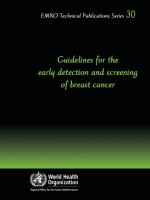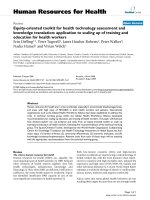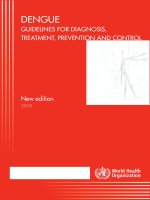ISO 28841:2013 Guidelines for simplified seismic assessment and rehabilitation of concrete buildings
Bạn đang xem bản rút gọn của tài liệu. Xem và tải ngay bản đầy đủ của tài liệu tại đây (2.48 MB, 84 trang )
INTERNATIONAL ISO
STANDARD 28841
First edition
2013-06-01
Guidelines for simplified seismic
assessment and rehabilitation of
concrete buildings
Lignes directrices pour l'évaluation sismique simplifiée et la
réhabilitation des structures en béton
Reference number
ISO 28841:2013(E)
© ISO 2013
ISO 28841:2013(E)
COPYRIGHT PROTECTED DOCUMENT
© ISO 2013
All rights reserved. Unless otherwise specified, no part of this publication may be reproduced or utilized in any form or by any means,
electronic or mechanical, including photocopying and microfilm, without permission in writing from either ISO at the address below or
ISO's member body in the country of the requester.
ISO copyright office
Case postale 56 CH-1211 Geneva 20
Tel. + 41 22 749 01 11
Fax + 41 22 749 09 47
Web www.iso.org
Published in Switzerland
ii © ISO 2013 – All rights reserved
ISO 28841:2013(E)
Contents Page
Foreword .............................................................................................................................................................v
Introduction ........................................................................................................................................................ vi
1 Scope ...................................................................................................................................................... 1
2 Normative references............................................................................................................................1
3 Terms and definitions ........................................................................................................................... 2
4 Symbols and abbreviated terms ........................................................................................................ 13
5 Limitations ........................................................................................................................................... 17
5.1 Occupancy ........................................................................................................................................... 17
5.2 Maximum number of stories .............................................................................................................. 18
5.3 Maximum aspect ratios.......................................................................................................................18
5.4 Maximum story height ........................................................................................................................ 18
5.5 Maximum difference in story height..................................................................................................18
5.6 Maximum difference in floor area ...................................................................................................... 18
5.7 Maximum difference in story mass ................................................................................................... 18
5.8 Maximum column offset ..................................................................................................................... 18
5.9 Maximum span length.........................................................................................................................18
5.10 Maximum difference in span length .................................................................................................. 18
5.11 Maximum cantilever span...................................................................................................................18
5.12 Maximum slope for slabs, girders, beams and joists......................................................................19
5.13 Maximum slope of the terrain ............................................................................................................ 19
5.14 Distance between center of mass and center of rigidity.................................................................19
6 Assessment and rehabilitation procedure........................................................................................19
6.1 Procedure outline ................................................................................................................................ 19
6.2 Data collection ..................................................................................................................................... 20
6.3 Lateral load resisting system classification ..................................................................................... 21
6.4 Material assessment ........................................................................................................................... 21
6.5 Condition assessment ........................................................................................................................ 21
6.6 Structural assessment ........................................................................................................................ 21
6.7 Rehabilitation design .......................................................................................................................... 21
6.8 Rehabilitation construction ................................................................................................................ 21
6.9 Design documentation........................................................................................................................21
7 General Guides .................................................................................................................................... 23
7.1 Limit states...........................................................................................................................................23
7.2 Ultimate limit state design format......................................................................................................23
7.3 Serviceability limit state design format.............................................................................................24
8 Classification of the structure system of the building .................................................................... 24
8.1 Concrete frame systems.....................................................................................................................24
8.2 Concrete wall systems........................................................................................................................24
8.3 Concrete dual systems ....................................................................................................................... 25
9 Condition assessment of structures damaged by a seismic event ............................................... 25
9.1 Material assessment ........................................................................................................................... 25
9.2 Condition Assessment........................................................................................................................28
9.3 Structural assessment ........................................................................................................................ 41
9.4 Final assessment.................................................................................................................................41
10 Condition assessment of existing structures .................................................................................. 41
10.1 Vulnerability level ................................................................................................................................ 41
10.2 Actual condition of the structure ....................................................................................................... 42
© ISO 2013 – All rights reserved iii
ISO 28841:2013(E)
10.3 Seismic hazard.....................................................................................................................................43
10.4 Architectural layout .............................................................................................................................45
10.5 Foundation ...........................................................................................................................................50
10.6 Soil type ................................................................................................................................................50
10.7 Quality aspects ....................................................................................................................................50
10.8 Structural assessment ........................................................................................................................51
10.9 Final assessment.................................................................................................................................52
11 Rehabilitation analysis and design....................................................................................................54
11.1 Concrete Frame Systems....................................................................................................................54
11.2 Concrete wall systems ........................................................................................................................54
11.3 Concrete frames with concrete infills................................................................................................55
11.4 Foundation rehabilitation....................................................................................................................55
11.5 Rehabilitation Measures for the structural system ..........................................................................55
12 Rehabilitation construction ................................................................................................................57
12.1 Demolitions and debris retrieval ........................................................................................................57
12.2 Cover retrieval......................................................................................................................................57
12.3 Surface preparations...........................................................................................................................57
12.4 Adherence concerns ...........................................................................................................................58
12.5 Durability concerns .............................................................................................................................58
Annex A (normative) Structural Assessment.................................................................................................59
A.1 Resistance ............................................................................................................................................59
A.2 Story drift..............................................................................................................................................63
A.3 Energy dissipation level......................................................................................................................65
A.4 Equivalent equations for material factors.........................................................................................69
A.5 Equivalent equations for material factors.........................................................................................73
Bibliography ......................................................................................................................................................76
iv © ISO 2013 – All rights reserved
ISO 28841:2013(E)
Foreword
ISO (the International Organization for Standardization) is a worldwide federation of national standards bodies
(ISO member bodies). The work of preparing International Standards is normally carried out through ISO
technical committees. Each member body interested in a subject for which a technical committee has been
established has the right to be represented on that committee. International organizations, governmental and
non-governmental, in liaison with ISO, also take part in the work. ISO collaborates closely with the
International Electrotechnical Commission (IEC) on all matters of electrotechnical standardization.
The procedures used to develop this document and those intended for its further maintenance are described
in the ISO/IEC Directives, Part 1. In particular the different approval criteria needed for the different types of
ISO documents should be noted. This document was drafted in accordance with the editorial rules of the
ISO/IEC Directives, Part 2. www.iso.org/directives
Attention is drawn to the possibility that some of the elements of this document may be the subject of patent
rights. ISO shall not be held responsible for identifying any or all such patent rights. Details of any patent
rights identified during the development of the document will be in the Introduction and/or on the ISO list of
patent declarations received. www.iso.org/patents
Any trade name used in this document is information given for the convenience of users and does not
constitute an endorsement.
The committee responsible for this document is ISO/TC 71, Concrete, reinforced concrete and pre-stressed
concrete, Subcommittee SC 5, Simplified design standard for concrete structures.
© ISO 2013 – All rights reserved v
ISO 28841:2013(E)
Introduction
The aim of this International Standard is to provide rules for the earthquake resistant assessment and
rehabilitation design and execution for existing structural concrete buildings for which simplified procedures
may be applied instead of more sophisticated and thorough analyses, in light of the simplicity, symmetry, and
other characteristics of the structure under study. This International Standard is developed for countries that
do not have existing national standards on this subject and to offer, to local regulatory authorities anywhere,
an alternative for the study of relatively small and simple buildings that abound in both rural and urban
environments. The analysis and design rules are based in simplified worldwide-accepted strength models.
This International Standard is self-contained; therefore actions (loads), simplified analysis procedures and
design specifications are included, as well as minimum acceptable construction practice guidelines.
The minimum dimensional guidelines contained in this International Standard are intended to account for
undesirable side effects that will otherwise require more sophisticated analysis and design procedures.
Material and construction guidelines are aimed at site-mixed concrete as well as ready-mixed concrete, and
steel of the minimum available strength grades.
The earthquake resistance guidelines are included for rehabilitation of concrete buildings in the numerous
regions of the world which lie in earthquake prone areas. The earthquake resistance of rehabilitated buildings
is based upon the employment of structural concrete walls (shear walls) that limit the lateral deformations of
the structure and provide for its lateral strength.
This International Standard contains guidelines that can be modified by the national standards body due to
local design and construction requirements and practices. These guidelines that can be modified are included
using ["boxed values"]. The authorities in each member country are expected to review the "boxed values"
and may substitute alternative definitive values for these elements for use in the national application of this
International Standard. Changes to boxed values shall not be made without thorough analyses and sound
supporting studies.
A great effort was made to include self-explanatory tables, graphics, and design aids to simplify the use of this
International Standard and provide foolproof procedures. Notwithstanding, the economic implications of the
conservatism inherent in approximate procedures as a substitute for sound and experienced engineering
should be a matter of concern to the designer that employs the document, and to the owner that hires him.
vi © ISO 2013 – All rights reserved
INTERNATIONAL STANDARD ISO 28841:2013(E)
Guidelines for simplified seismic assessment and rehabilitation
of concrete buildings
1 Scope
This International Standard can be used as an alternative to the development of a building code, or equivalent
document in countries where no national design codes are available by themselves, or as an alternative to the
building code in countries where specifically considered and accepted by the national standards body or other
appropriate regulatory organization, and applies to the assessment of earthquake resistance capability and to
the seismic rehabilitation design and construction for existing structural concrete buildings.
The purpose of these guidelines is to provide sufficient information to perform the seismic assessment and
rehabilitation of the structural concrete building that complies with the limitations established in Clause 5, for
both undamaged structures that are deemed not to comply with the required characteristics for an adequate
response at a specified performance level, and for structures that have undergone damage under seismic
loadings. The rules of design as set forth in this International Standard are simplifications of more elaborate
requirements.
Although the guidelines contained in this International Standard were drawn to produce, when properly
employed, a reasonable assessment of the seismic vulnerability of an undamaged structure, a reasonable
assessment of a structure damaged by a seismic event and a structural rehabilitation of the assessed
concrete structure with an appropriate margin of safety, these guidelines are not a replacement for sound and
experienced engineering. In order to attain the intended results on assessment and rehabilitation design, this
International Standard must be used as a whole, and alternative procedures should be employed only when
explicitly permitted by the guidelines. The minimum dimensioning guides as prescribed in this International
Standard replace, in most cases, more elaborate procedures such as those prescribed in the national code or,
if no national code exists, in internationally recognized full fledged codes, and the possible economic impact is
compensated for by the simplicity of the procedures prescribed here.
The professional applying the procedures set forth by these guidelines should meet the legal requirements for
structural designers in the country of adoption and have training and a minimum appropriate knowledge of
structural mechanics, statics, strength of materials, structural analysis, and reinforced concrete design and
construction.
While buildings rehabilitated in accordance with these guidelines are expected to perform within the selected
performance levels for the applicable design earthquakes, compliance with these guidelines is necessary but
may not guarantee the sought for performance, as current knowledge of structural behavior under seismic
loads, and of the loads themselves, is still incomplete.
2 Normative references
The following documents, in whole or in part, are normatively referenced in this document and are
indispensable for its application. For dated references, only the edition cited applies. For undated references,
the latest edition of the referenced document (including any amendments) applies.
ISO 15673:2005, Guidelines for the simplified design of structural reinforced concrete for buildings
© ISO 2013 – All rights reserved 1
ISO 28841:2013(E)
3 Terms and definitions
For the purposes of this document, the following terms and definitions apply.
3.1
acceleration of gravity, g
acceleration produced by gravity at the surface of the earth
NOTE For the application of these guidelines its value can be approximated to 10 m/s2.
3.2
adherence
force acting on the interface of two solid materials
3.3
admixture
material other than water, aggregate, or hydraulic cement, added to concrete before or during its mixing to
modify its properties
3.4
aggregate
granular material, such as sand, gravel, crushed stone, and iron blast-furnace slag, used in conjunction with
cementitious materials to form a hydraulic cement concrete or mortar
3.5
anchorage
devices used to anchor a non-structural element to the structural framing
3.6
bar diameter, nominal
approximate diameter of a steel reinforcing bar, often used as a class designation
NOTE For deformed bars, it is common practice to use the diameter of a plain bar having the same area.
3.7
beam
structural member for which ratio of axial load to axial gross capacity is equal to or less than 0,1.
3.8
bearing capacity of the soil
maximum permissible stress on the foundation soil that provides adequate safety against bearing failure of the
soil
NOTE Its value is defined at the working stress level.
3.9
bending moment
product of a force and the distance to a particular axis, producing bending effects in a structural element
3.10
boundary elements
structural elements embedded at the ends of structural walls strengthened by transverse reinforcement to
confine the longitudinal reinforcement
NOTE Boundary elements may require an increase in thickness of the wall.
2 © ISO 2013 – All rights reserved
ISO 28841:2013(E)
3.11
caisson
foundation pile of large diameter, built partly or totally above ground and sunk below ground usually by digging
out the soil inside
3.12
carbonation
process of conversion of calcium hydroxide in hardened cementitious material into calcium carbonate due to
reaction with carbon dioxide diffused into the cement paste from the atmosphere
3.13
cement
material as specified in the corresponding referenced ISO standards, which, when mixed with water, has
hardening properties
3.14
center of mass
geometric plan location of the resultant force due to the action of gravity on the mass of the floor is located,
supposing the floor diaphragm as an infinite rigid body in its own plane
3.15
center of rigidity
geometric plan location of the resultant of the resistance forces due to structural vertical elements stiffness,
calculated, supposing that the floor diaphragm is an infinite rigid body in its own plane in such a way that when
applying a horizontal force in any direction, rotation of the diaphragm takes place with no distortion of the
original shape of the floor
3.16
corrosion
process of disintegration of the reinforcing steel bars due to chemical or electromechanical change caused in
presence of moisture
3.17
column
structural member in which the ratio of axial compressive loads to axial gross capacity is more than 0,1
3.18
collector elements
structural elements that carry the forces within a horizontal diaphragm to the lateral-force resisting system
3.19
combined footing
footing that transmits to the supporting soil the load carried by several columns or structural concrete walls
3.20
compression reinforcement
reinforcement provided to resist compression stresses in the member section
3.21
concrete
mixture of cementitious materials with fine aggregate, coarse aggregate, and water, with or without admixtures,
to form a hardened material with specific strength properties
3.22
concrete mix design
choice and proportioning of the ingredients of concrete
© ISO 2013 – All rights reserved 3
ISO 28841:2013(E)
3.23
concrete specified compressive strength, f c
compressive strength of cylindrical concrete specimens used in design and evaluated in accordance with the
appropriate ISO standard, expressed in megapascals (MPa)
NOTE Whenever the quantity ' is under a radical sign ( fc' ), the positive square root of numerical value only is
fc
intended, and the corresponding result has units of megapascals (MPa).
3.24
confinement hook
hook at the ends of a stirrup, hoop, or crosstie having a bend of not less than 135° with a six-diameter (but not
less than 75 mm) extension that engages the longitudinal reinforcement and projects into the interior of the
stirrup, hoop or crosstie
3.25
confinement stirrup or tie
closed stirrup, tie or continuously wound spiral
NOTE A closed stirrup or tie can be made up of several reinforcement elements each having confinement hooks at
both ends. A continuously wound spiral should have a confinement hook at both ends.
3.26
cover, concrete
thickness of concrete between the surface of any reinforcing bar and the nearest face of the concrete member
3.27
crack
break, with or without quite separating in two parts, of concrete, usually near or at the surface
3.28
creep
unrecoverable strain caused to a material subjected to constant stress for a long duration
3.29
crosstie
continuous reinforcing bar having a 135° hook at one end and a hook not less than 90° at least a six-diameter
extension at the other end
NOTE The hooks should engage peripheral longitudinal bars. The 90° hooks of two successive crossties engaging
the same longitudinal bars should be alternated end for end.
3.30
curing
process in which concrete is kept damp for a period of several days, starting from the moment it is cast, in
order to prevent evaporation of water within the cementitious paste to ensure that the hardening process
attains the intended strength
NOTE Appropriate curing will greatly reduce shrinkage, increase strength of concrete, and should reduce surface
cracking. Curing time will depend on temperature and relative humidity of surrounding air, the amount of wind, the direct
sunlight exposure, the type of concrete mix employed, and other factors.
3.31
dead load
permanent load
load in which variations over time are rare or of small magnitude
NOTE All other loads are variable loads (see also nominal loads).
4 © ISO 2013 – All rights reserved
ISO 28841:2013(E)
3.32
deformed reinforcement
steel reinforcement that has deformations in its surface to increase its bond to the concrete
NOTE The following steel reinforcement should be considered deformed reinforcement under these guidelines:
deformed reinforcing bars, deformed wire, welded plain wire fabric, and welded deformed wire fabric conforming to the
appropriate ISO standards.
3.33
depth of member, h
vertical dimension of a cross section of a horizontal structural element or cross section dimension parallel to
the direction of transversally applied loads to vertical structural elements
3.34
design load combinations
combinations of factored loads and forces as specified in these guidelines
3.35
design strength
product of the nominal strength and a strength reduction factor
3.36
development length
length of embedded reinforcement required to develop the design strength of reinforcement at a critical
section
3.37
development length for a bar with a standard hook
minimum length to be provided between the critical section (where the strength of the bar is to be developed)
and a tangent to the outer edge of the 90° or 180° hook
3.38
differential settlement
non-uniform vertical displacement of the foundation
3.39
drift
difference between the horizontal displacements of two floor levels
3.40
durability
characteristics of a structure to resist gradual degradation of its serviceability in a given environment for the
design service life
3.41
effective depth of section, d
distance measured from extreme compression fiber to centroid of tension reinforcement
3.42
embedment length
length of embedded reinforcement provided beyond a critical section
3.43
fatigue
weakening of a material by load cycles, with or without load reversals
3.44
factored loads and forces
specified nominal loads and forces multiplied by the load factors prescribed in these guidelines
© ISO 2013 – All rights reserved 5
ISO 28841:2013(E)
3.45
fire protection of reinforcement
amount of concrete cover necessary for protection of the reinforcement against the effects of the high
temperatures produced by fire
NOTE The concrete cover is a function of specified fire resistance, measured in hours.
3.46
flange
top or bottom part of an “I” or “T” shaped section
3.47
flexural
pertaining to the effect of flexure
3.48
flexural reinforcement
reinforcement provided to resist the tensile stresses induced by flexural moments acting on the member
section
3.49
footing
that portion of the foundation which transmits loads directly to the soil
NOTE May be the widening part of a column, a structural concrete wall or several columns, in a combined footing.
3.50
formwork
temporary construction to contain concrete in a plastic state while it is cast and setting, and which provides the
final shape of the element as the concrete hardens
3.51
foundation
part of the structure that transmits loads to the underlying soil
NOTE A retaining wall is a special kind of foundation that resists the pressure exerted by the soil on sloping or
vertical excavations
3.52
foundation beam
beam that rests on the foundation soil and spans between footings, used either to support walls or to limit
differential settlement of the foundation
3.53
foundation mat
continuous slab laid over the ground as part of the foundation and that transmits to the underlying soil the
loads from the structure
3.54
frame system
system in which seismic shear forces are resisted by shear and flexure in members and joints of a frame
3.55
girder
main horizontal support beam, usually supporting other beams
3.56
gravity loads
loads that act downward and are caused by the acceleration of gravity, g, acting on the mass of the elements
6 © ISO 2013 – All rights reserved
ISO 28841:2013(E)
3.57
hook
bend at the end of a reinforcing bar
NOTE They are defined by the angle that the bend forms with the bar as either 90°, 180° or 135° hooks.
3.58
joist
beam used in parallel series directly supporting floor and ceiling loads, and supported in turn by larger girders,
beams, or bearing structural concrete walls
3.59
lap splice
splice between two reinforcing bars obtained by overlapping them through a specified length
3.60
lateral-force resisting system
portion of the structure composed of members proportioned to resist forces related to earthquake or wind
effects
3.61
lightweight aggregate concrete
concrete made with coarse granular material that weighs less than the granular material used in normal
weight concrete
NOTE This type of concrete is not covered by these guidelines.
3.62
limit state
condition beyond which a structure or member becomes unfit for service and is judged either to be no longer
useful for its intended function (serviceability limit state) or to be unsafe (strength limit state)
3.63
live loads
all forces that are variable within the structure’s normal operation, not including construction or environmental
loads
3.64
load effects
forces and deformations produced in structural members by the applied loads
3.65
load factor
factor that accounts for deviations of the actual load from the nominal load due to uncertainties both in load
calculation and load effect analysis, and to account for the probability that more than one extreme load will
occur simultaneously
3.66
loads
forces or other actions that result from the weight of all building materials, pedestrians, environmental effects,
differential movement, and restrained dimensional changes
3.67
longitudinal reinforcement
reinforcement that is laid parallel to the longitudinal axis of the element, generally to account for flexural
effects
3.68
mass
quantity of matter in a body
© ISO 2013 – All rights reserved 7
ISO 28841:2013(E)
3.69
modulus of elasticity
ratio of normal stress to corresponding strain for tensile or compressive stresses below proportional limit of
material
3.70
negative moment
flexural moment that produces tension stresses at the upper part of the section of a horizontal or nearly
horizontal element, and that requires placing negative flexural reinforcement in the upper part of the element
section
3.71
negative reinforcement
in horizontal or nearly horizontal elements, the flexural reinforcement required for negative moment and that is
placed in the upper part of the section of the element
3.72
nominal loads
magnitudes of the loads specified in these guidelines (dead, live, soil, wind, snow, rain, flood, and earthquake),
before applying magnifying or reducing factors
3.73
nominal strength
capacity of a structure or member to resist the effects of loads, as determined by computations using specified
material strengths and dimensions and the formulas set forth by these guidelines
NOTE Specified material strengths are derived from accepted principles of structural mechanics or by field tests or
laboratory tests of scaled models, allowing for modelling effects and differences between laboratory and field conditions
3.74
overturning
action resulting when the moment produced at the base of vertical lateral force resisting elements is larger
than the resistance provided by the building weight and foundation resistance to uplift
3.75
pedestal
upright compression member with a ratio of unsupported height to average least lateral dimension of less
than 3
3.76
performance level
limiting damage state for a building, considering structural and nonstructural components
3.77
pile
slender timber, concrete or structural steel element embedded in the ground to support loads
3.78
plain reinforcement
smooth surfaced steel reinforcement, or reinforcement that does not conform to the definition of deformed
reinforcement
3.79
positive moment
flexural moment that produces tension stresses at the lower part of the section of a horizontal, or nearly
horizontal element, and that requires placing positive flexural reinforcement in the lower part of the element
section
8 © ISO 2013 – All rights reserved
ISO 28841:2013(E)
3.80
positive reinforcement
in horizontal or nearly horizontal elements, the flexural reinforcement required for positive moment and that is
placed in the lower part of the section of the element
3.81
reaction
resistance to a force or load, or upward resistance of a support such as a structural concrete wall or column
against the downward pressure of a loaded member such as a beam
3.82
rehabilitation
process of repairing or reinforcing a structure to achieve a desired useful condition
NOTE Also known as retrofit.
3.83
reinforcement
steel bars, wire, or wire mesh, used for reinforcing the concrete to improve its performance when tensile
stresses are expected, due either to the applied loads, or to environmental effects such as variation of
temperature
3.84
required factored strength
strength of a member or cross section required to resist factored loads or related internal moments and forces
in such combinations as are stipulated by these guidelines
3.85
retaining wall
wall built to support lateral earth or liquid pressure
3.86
seismic hazard
level of seismic actions at the building site quantified in terms of the horizontal effective acceleration of the
ground, which has a given probability of being exceeded in a predetermined lapse of time
3.87
selfweight
weight of the structural element, caused by the mass of the materials in elements and structure
3.88
service load
unfactored loads specified by these guidelines
3.89
settlement
downward movement of the supporting soil
3.90
shear force
internal force, resulting from shear stresses acting parallel to the plane of a cross section of an element
3.91
shear reinforcement
reinforcement proportioned to resist shear forces
© ISO 2013 – All rights reserved 9
ISO 28841:2013(E)
3.92
shores
temporary structural members designed to support the weight of the formwork, concrete, and construction
loads
3.93
shrinkage and temperature reinforcement
reinforcement provided for shrinkage and temperature stresses in structural solid slabs and footings
3.94
skew
part of a structure that deviates from a straight line or from a right angle
3.95
slab
solid flat part of a reinforced concrete deck carried by supporting joists or beams or girders
3.96
solid slab
deck or floor system comprised of a slab of uniform thickness that does not have voids or that has voids with
size less than 0,6 times the slab thickness
3.97
spalling
loss of material at the surface of a concrete element due to breakage or splitting off in chips or bits, usually
due to expansive force within the mass of concrete
3.98
span length
distance between supports of a horizontal structural element
3.99
specifications
written document describing in detail the scope of work, materials to be used, method of installation, and
quality of workmanship
3.100
specified lateral earthquake forces
lateral forces corresponding to the appropriate distribution of the design base shear force prescribed by these
guidelines, for earthquake-resistant design
3.101
specified wind forces
nominal pressure of wind to be used in design performed in accordance with these guidelines
3.102
spiral reinforcement
continuously wound reinforcement in the form of a cylindrical helix
3.103
spread footing
isolated footing that transmits to the supporting soil the load carried by a single column
3.104
stirrup
reinforcement used to resist shear and torsion stresses in a structural member
NOTE Typically bars, wires, or welded wire fabric (plain or deformed) either single leg or bent into L, U, or
rectangular shapes and located perpendicular to or at an angle to longitudinal reinforcement. (The term "stirrups" is
10 © ISO 2013 – All rights reserved
ISO 28841:2013(E)
usually applied to lateral reinforcement in girders, beams, and joists; the term "ties" to those in columns and walls, perhaps
because they are intended also as confinement for the longitudinal reinforcement.).
3.105
stiffness
measure of difficulty to bend or flex a structural element or a structure expressed as the necessary force to
cause a unitary deformation
NOTE When applied to qualify a building story, it is expressed as the ratio between the story total shear force and the
story drift, under lateral loading.
3.106
strength
maximum axial force, shear force or moment that can be resisted by a component
3.107
strengthening
measures taken for a deteriorated structure or any of its structural members to restore its design load carrying
capacity
3.108
strength reduction factor,
coefficient that accounts for deviations of the actual strength from the nominal strength, according to the
manner and consequences of failure
NOTE Includes the probability of reduced strength due to variations in material strengths and dimensions,
approximations in the design equations, to reflect the degree of ductility and required reliability on the member under the
load effects being considered, and to reflect the importance of the element in the structure.
3.109
stress
intensity of force per unit area
3.110
structural concrete
all concrete used for structural purposes including reinforced and prestressed concrete
3.111
structural concrete walls
walls proportioned to resist combinations of shear, moments, and axial forces including but not limited to
selfweight and forces applied directly to it
NOTE A "shearwall" is a "structural wall".
3.112
structural diaphragms
structural systems, such as floor and roof decks, which transmit forces induced by lateral motions
3.113
support
structural element that provides bearing and movement restriction to other structural or non-structural
elements
3.114
tie
loop of reinforcing bar or wire enclosing longitudinal reinforcement
NOTE A continuously wound bar or wire in the form of a circle, rectangle, or other polygon shape without re-entrant
corners is acceptable.
© ISO 2013 – All rights reserved 11
ISO 28841:2013(E)
3.115
tie elements
elements which serve to transmit inertia forces and prevent separation of components such as footings and
walls
3.116
transverse reinforcement
reinforcement located perpendicular to the longitudinal axis of the element, such as stirrups, ties, spiral
reinforcement, among others
3.117
vulnerability level
quantification of the potential of a building for inadequate performance under any set of loads including
environmental actions
3.118
wall
member, usually vertical and whose length and height are much larger than its thickness
3.119
web
thin vertical portion of an “I” or “T” shaped section that connects the flanges
3.120
weight
vertical downward force exerted by a mass when subjected to the acceleration of gravity
NOTE The weight is equal to the value of the mass multiplied by the acceleration of gravity, g.
3.121
wire
slender stringlike steel filament, usually of circular section, of small diameter
3.122
wire mesh
welded-wire fabric reinforcement
3.123
working stress
allowable stress to be used with unfactored loads
3.124
yield strength, fy
specified minimum stress at which steel initiates yielding
NOTE 1 The yield strength is expressed in units of megapascals (MPa).
NOTE 2 Applicable international standards specify that the yield strength be determined for steel subjected to tensile
forces.
12 © ISO 2013 – All rights reserved
ISO 28841:2013(E)
4 Symbols and abbreviated terms
For the purposes of this document, the following symbols and definitions apply².
Symbol Explanation Unit
A Depth of equivalent uniform compressive stress block mm
Ab Area of an individual reinforcement bar or wire mm²
Ac Loaded area of bearing on concrete or the area of the confined column core mm²
Ag Gross area of section of element mm²
Aj Effective cross-sectional area within a joint for shear evaluation or area of additional mm²
hanger reinforcement
As Area of longitudinal tension reinforcement mm²
A's Area of longitudinal compression reinforcement mm²
As, min Minimum area of longitudinal tension reinforcement mm²
Total extreme steel area in a column or structural concrete wall for computation of the mm²
Ase balanced moment strength
Total side steel area in a column or structural concrete wall for computation of the mm²
Ass balanced moment strength
Total area of longitudinal reinforcement mm2
Ast Wind exposed surface area m2
Asu Area of shear reinforcement within a distance s mm²
Av Depth of equivalent uniform compressive stress block mm
a Fraction of the load that travels in the short direction in two-way slabs-on-girders -
a Fraction of the load that travels in the long direction in two-way slabs-on-girders -
b Constant used to compute nominal punching shear strength in slabs -
s Width of compression face of member, or width of the section of the member mm
B Width of compression face of member, or width of the section of the member mm
b Width of the column section, or largest plan dimension of capital or drop panel, for mm
punching shear evaluation
bc Dimension of column section in the direction perpendicular to the girder span m
Effective width of the compression flange in a T-shaped section mm
bcol Web width in a T-shaped section, or web width of girders, beams or joists, or thickness
bf of the web in a structural concrete wall mm
Perimeter of critical section for punching shear in slabs
bw mm
Ratio of clear spans in long to short direction of two-way slabs -
b0 -
Dead loads, or related internal moments and forces
Effective depth, should be taken as the distance from extreme compression fiber to mm
centroid of tension reinforcement
D Distance from extreme compression fiber to centroid of compression reinforcement mm
Nominal diameter of reinforcing bar or wire mm
d Distance from extreme tension fiber to centroid of tension reinforcement or diameter of
the confined core of column with spiral reinforcement mm
d' Diameter of pile, at footing base
db Load effects of earthquake, or related internal moments and forces mm
-
dc
dP
E
© ISO 2013 – All rights reserved 13
ISO 28841:2013(E)
Symbol Explanation Unit
Ec Modulus of elasticity of concrete MPa
F Loads due to weight and pressures of fluids with well-defined densities and controllable
maximum heights, or related internal moments and forces -
Fi, Fx Design wind or seismic force applied at level i or x, respectively kN
Fa Soil coefficient -
Fiu, Fxu Factored design lateral force applied to the wall at level i or x, respectively N
f'c Specified compressive strength of concrete MPa
MPa
f c´ Positive square root of specified compressive strength of concrete MPa
fcd MPa
fcu Compressive strength of concrete reduced by the material factor MPa
fy Extreme fibre factored compressive stress at edges of structural walls MPa
fyd Specified yield strength of reinforcement. MPa
fypr Yield strength of reinforcement reduced by the material factor. MPa
fys Probable specified maximum strength of reinforcement, (fypr = 1,25 ·fy). MPa
fysd Specified yield strength of transverse or spiral reinforcement. -
mc Yield strength of transverse or spiral reinforcement reinforcement reduced by the -
material factor. -
Material factor for concrete. -
H Material factor for steel. mm
Strength reduction factor. mm
h Loads due to the weight and pressure of soil, water in soil, or other materials, or related m
internal moments and forces. mm
hb Depth or thickness of structural element or overall thickness of member. mm
hcol Vertical distance measured from the bottom of the supporting girder to the bottom of the m
hc supported beam. mm
hf Dimension of column section in the direction parallel to the girder span. mm
hi, hx Height of the column section. mm
hn Slab thickness. mm
hpi Height above the base to level i or x, respectively. -
hs Clear vertical distance between lateral supports of columns and walls. m4
hw Story height of deck I, measured from deck finish of the story to deck finish of the story m
l immediately below.
Total height of the supporting girder. m
Ic Height of entire structural concrete wall from base to top. mm
la Span of structural element or length of span measured center-to-center of beams or
other supports
lb Moment of inertia of the column section.
ld Length of clear span in the short direction of two-way slabs, measured face-to-face of
beams or other supports.
Length of clear span in the long direction of two-way slabs, measured face-to-face of
beams or other supports.
Development length for reinforcing bar.
14 © ISO 2013 – All rights reserved









